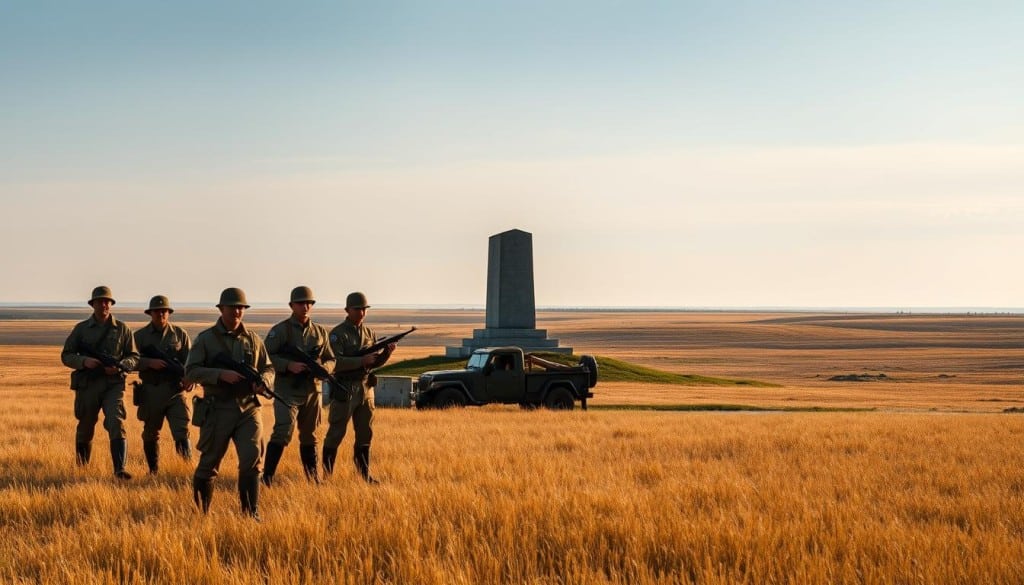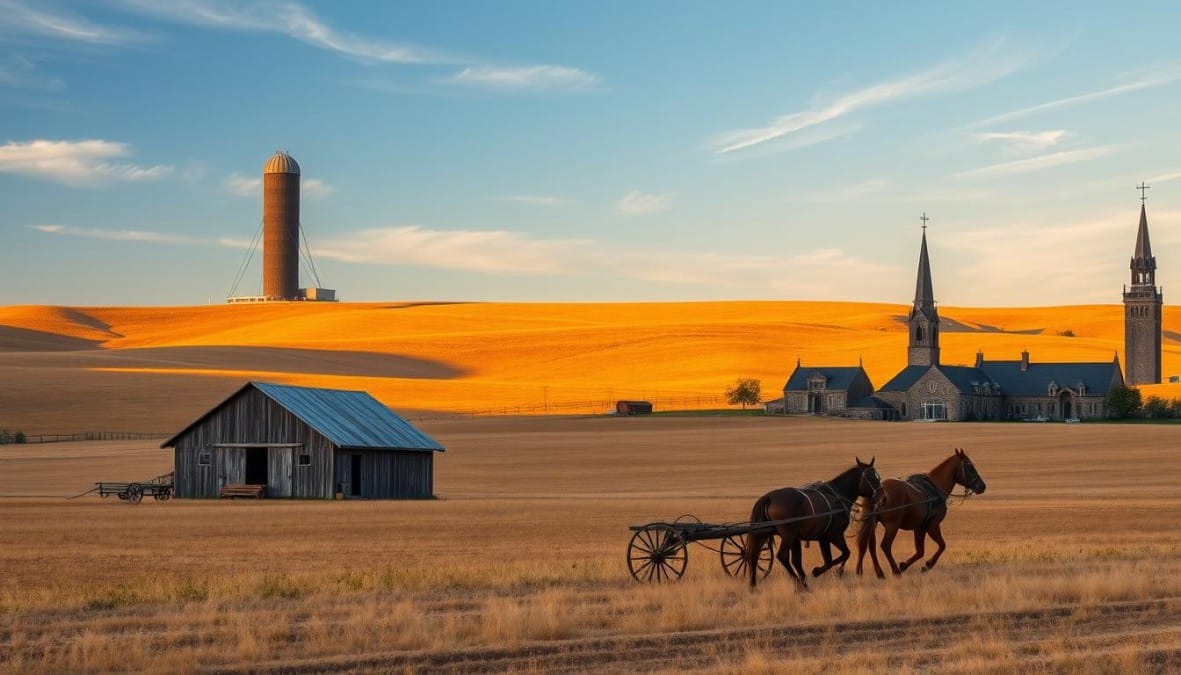Travel back in time over 500 million years. You’d find yourself wading in a shallow sea where now the prairie skies stretch wide. Fast forward to today, that ancient seabed has turned into Saskatchewan. This province boasts a rich history, stretching from prehistoric times to a modern hub of agriculture.
Let’s pay tribute to the Saskatchewan pioneers. Their hard work and resilience founded a province that ties Canada together. They settled in lands rich with fertile soils, left by glaciers long ago. Their legacy is as profound as the land itself, marking Saskatchewan’s significant place in Canada’s story.
We’ll explore the history of Saskatchewan, from ancient Indigenous voices to today’s bustling cities. This province thrives on a legacy of nature and achievements. We are all part of this ongoing story.
1. Introduction to Saskatchewan’s Rich History
Welcome to an exploration of Indigenous history in Saskatchewan. This journey also looks at how Saskatchewan joined the Confederation. We’re not just learning facts. We’re connecting with the deep stories of this land.
In the late 1800s, big changes started on Canada’s prairies. What we know as Saskatchewan moved from being Rupert’s Land, under the Hudson’s Bay Company, to being its own province in 1905. This was a key event in its history.
Overview of the Province’s Formation
The path to becoming a province was shaped by talks and treaties with Indigenous peoples. These dealings were vital for Saskatchewan’s role in Canada.
Importance of Indigenous Cultures
Indigenous groups like the Cree, Saulteaux, and Assiniboine were key in protecting the land. They kept alive rich traditions, languages, and rituals. Knowing about this history shows us about their connection to the land and each other.
We see Saskatchewan’s unique story through its Indigenous peoples and shared history. This shapes the province’s identity today.
2. Indigenous Peoples of the Prairies
Saskatchewan’s cultural roots are deeply tied to its first people. The First Nations and Métis have preserved traditions for thousands of years. These traditions are key to understanding the prairies’ diverse culture. They are not just historical but also enrich our lives today.
The connection to the land is evident in their way of life. Activities like hunting and spiritual rituals shaped their social and cultural identity. Using resources like caribou and buffalo was essential. It determined social roles and supported the economy through trading.
Learning about the fusion of cultures in Saskatchewan gives us a wider view of its heritage. This heritage teaches us to respect nature and work together. These values help us strive to be better in our present day.
- The Taltheilei Tradition, showcasing tool and weapon craftsmanship
- Shield Archaic tradition, significant for its use in storytelling and art
- Social traditions like communal hunting and the sharing of resources
By embracing First Nations values, we learn about sustainability and community. Celebrating these traditions keeps Saskatchewan’s heritage alive and growing. It turns history into a living story that benefits everyone.
3. European Exploration and Settlement
Looking back at Saskatchewan’s fur trade history, we can’t miss Henry Kelsey. He was an early European explorer who arrived in 1690. His arrival started an era of deep exploration. It also marked the start of the fur trade, an important activity that shaped the region.
This period included not only explorers and traders. It also saw interactions with indigenous communities. These interactions created a complex mix of relationships and exchanges.
The fur trade in Saskatchewan was boosted by groups like the Hudson’s Bay Company and the North West Company. These groups built strong alliances and rivalries. This happened both among European competitors and with indigenous nations. These interactions created a network of trade routes. They made Saskatchewan a key spot in the North American fur trade.

The early explorations and the growing fur trade touched many aspects of life. They influenced where settlements formed, economic practices, and cultural exchanges. As explorers, including Henry Kelsey, moved through these lands, they did more than map them. They laid the foundation for future economic systems in the prairie province.
| Explorer | Contribution |
|---|---|
| Henry Kelsey | First European to explore the central prairies; pivotal in establishing fur-trade routes in Saskatchewan |
| Hudson’s Bay Company | Key player in the fur trade, establishing posts and routes throughout the region |
| North West Company | Competed with Hudson’s Bay Company, expanding trade networks deep into Saskatchewan |
4. The Creation of the Province
We at Canadians Together are proud to tell the story of how Saskatchewan came to be. Its journey from a wide-open territory to a province is a key part of Saskatchewan Confederation history . We’ll explore how the Dominion of Canada helped make this happen, leading to years of growth.
Saskatchewan’s start as a province ties closely with smart policies like the *Dominion’s Homestead Act*. This act wasn’t just a policy. It led thousands to make the Prairies their home, building a strong farming community that’s vital to our economy even now.
The story of Saskatchewan becoming a province is truly moving. After buying Rupert’s Land, Canada aimed to fill the vast lands west of Ontario with people. The Canadian Pacific Railway’s completion made moving there easier, supporting this goal.
To better grasp how Saskatchewan became a province, we have outlined the major events:
| Event | Description | Impact |
|---|---|---|
| Purchase of Rupert’s Land | The Dominion of Canada acquires vast territories from the Hudson’s Bay Company. | Laid the groundwork for governmental jurisdiction and development plans in the west. |
| Dominion’s Homestead Act | A policy offering 160 acres of land to settlers for a minimal filing fee. | Sparked a massive wave of immigration and settlement, leading to rapid agricultural development. |
| Canadian Pacific Railway Completion | The transcontinental railway was completed in 1885, linking eastern Canada to the Prairies. | Facilitated easier movement of people and goods, essential for regional growth and integration into the national economy. |
| Establishment as a Province | Saskatchewan was officially recognized as a province in 1905. | Marked a new chapter in local governance and increased political representation in the Canadian Confederation. |
Our province’s creation was fueled by vision, hard work, and a shared goal of progress and unity. These early efforts still shape how Saskatchewan grows and unites within the Canadian Confederation today.
5. Homesteading and Agricultural Growth
The Dominion Lands Act of 1872 was key for Saskatchewan’s economic growth . It made land distribution easier, sparking an amazing change in the area’s agriculture. It gave settlers 160 acres of farmland, bringing many Europeans keen on a new beginning.
This act led to big improvements in farming in Saskatchewan under the Dominion Lands Act . Farming methods got better, moving from old ways to new, efficient techniques. These changes helped start a period of steady agricultural expansion that shaped the province’s economy.
| Year | Settler Origin | Introduced Farming Technique |
|---|---|---|
| 1872-1885 | British | Crop Rotation |
| 1886-1900 | German | Intensive Wheat Cultivation |
| 1901-1915 | Scandinavian | Dairy Farming |
| 1916-1930 | Dutch | Advancements in Animal Husbandry |
| 1931-1945 | Finnish | Organic Farming Techniques |
We honor the huge influence of the Dominion Lands Act on Saskatchewan’s economic development history . It didn’t just boost farming; it made Saskatchewan a place of diversity. Various communities added their unique touch, greatly enhancing the region’s agriculture.
6. Saskatchewan During the World Wars
During the World Wars, Saskatchewan’s role in Canadian history stood out because of its big contributions. These events changed our province in many ways, making our community stronger and more united.
Contributions to the War Efforts
Saskatchewan showed its pride by sending many volunteers to fight and helping with resources. Local farms changed what they grew to produce more food for the war. This helped supply things like wheat and meat which were greatly needed.
Many people also volunteered in factories and helped raise money for the war. This showed how everyone in the province was ready to help the national cause. It also showed how important Saskatchewan’s role in Canadian history was during these times.
Changes in Society and Economy
The wars brought big changes to Saskatchewan, changing things during the wars and after. With fewer people to work, women started doing jobs usually done by men. This started changing how people thought about women’s work and gender roles.
There were also new farming technologies because more food production was needed. These changes in farming didn’t go away when the wars ended. They helped make Saskatchewan a leader in farming innovations in Canada.
| Period | Impact on Society | Impact on Economy |
|---|---|---|
| World War I | Increased female workforce participation | Boost in agricultural output |
| World War II | Societal shifts in gender roles | Proliferation of mechanized farming techniques |

The World Wars sped up changes in Saskatchewan, in both society and the economy. These tough times made our community’s resilience stronger. They also made our contributions to the country stand out. This shows how important Saskatchewan’s role in Canadian history is as a source of strength and new ideas.
7. The Great Depression and Its Impact
In the early 1930s, Saskatchewan felt a major economic hit. This time became a critical chapter in Saskatchewan’s economic history . The Great Depression in Saskatchewan caused a lot of financial pain, especially for farmers and their families.
The government of Saskatchewan stepped in with relief efforts to help people. These efforts weren’t just about giving aid. They aimed to change the economy for better future security.
| Year | Agricultural Output | Unemployment Rate | Relief Provided |
|---|---|---|---|
| 1930 | Low | 25% | $5 million |
| 1934 | Very Low | 30% | $10 million |
| 1938 | Moderate | 15% | $8 million |
The efforts to tackle the crisis set the stage for future reforms. The Great Depression in Saskatchewan taught enduring lessons. These lessons in handling economic trouble and governance remain influential in shaping policies.
8. The Rise of Socialism in Saskatchewan
In Saskatchewan, economic challenges changed politics. The area embraced socialism, a major shift in its history. The Co-operative Commonwealth Federation (CCF) began this change, with Tommy Douglas leading. His ideas transformed not just Saskatchewan but also Canada.
Formation of the Co-operative Commonwealth Federation
The 1930s brought tough times, sparking a new movement. The CCF was created to fight economic unfairness. It wanted to make life better for workers and farmers by managing resources democratically.
- Economic reform through public ownership of key industries
- Implementation of social welfare programs to support the needy and unemployed
- Introduction of progressive taxation to redistribute wealth fairly
Influence of Tommy Douglas
Tommy Douglas was a leader with big ideas, especially in health. As head of the CCF and Saskatchewan’s premier, he started socialized medicine. This idea grew and helped shape Canada’s healthcare today.
“Tommy Douglas was not only a skilled politician but also a compassionate leader, whose dedication to healthcare reformed the lives of millions of Canadians.”
Douglas worked hard for social justice and equality in Saskatchewan. He’s known for making big changes in social welfare. His work made Saskatchewan a leader in social reform.
The CCF and Tommy Douglas really changed Saskatchewan. They built a government that cared about people. Their work is a key part of Saskatchewan’s and Canada’s history.
9. Saskatchewan’s Cultural Mosaic
Exploring Saskatchewan cultural heritage highlights our province’s deep-rooted diversity in Saskatchewan . This diversity, brought to life by new immigrants, shapes our identity. Each group adds its unique essence to our community’s fabric.
Ukrainian dances and German culinary arts are examples of tradition in our day-to-day life. These cultures have enriched our farms and our cultural heritage. This makes Saskatchewan stand out.
Celebrating our diversity, we enjoy festivals that highlight our cultural blend. These events foster understanding and let us enjoy arts and foods from various cultures.
Immigrant communities have a key role in our cultural landscape. They help make our society diverse and welcoming. This cultural mosaic boosts our social connections and adds to Saskatchewan’s cultural heritage . By valuing our diversity, we build a united, culturally rich community.
10. Modern Developments and Future Directions
Saskatchewan is a vital part of Canada’s growing economy, full of progress and promise. As we moved into the 21st century, Saskatchewan has embraced change and innovation. Technology and mining have joined with farming to help our province grow. This growth combines our natural riches with new digital advancements.
With this growth, we think about keeping Saskatchewan bright and sustainable. We’ve tackled challenges with creativity and teamwork. Our commitment to the environment and diverse cultures makes us stronger. Together, we make decisions that steer Saskatchewan toward a bright future.
We are journeying toward a future filled with new chances while remembering our roots. Our goal is to keep our economy strong, respect our past, and aim for a future where all dreams can come true. By working together, we’re making a future that shows Saskatchewan’s true spirit.






